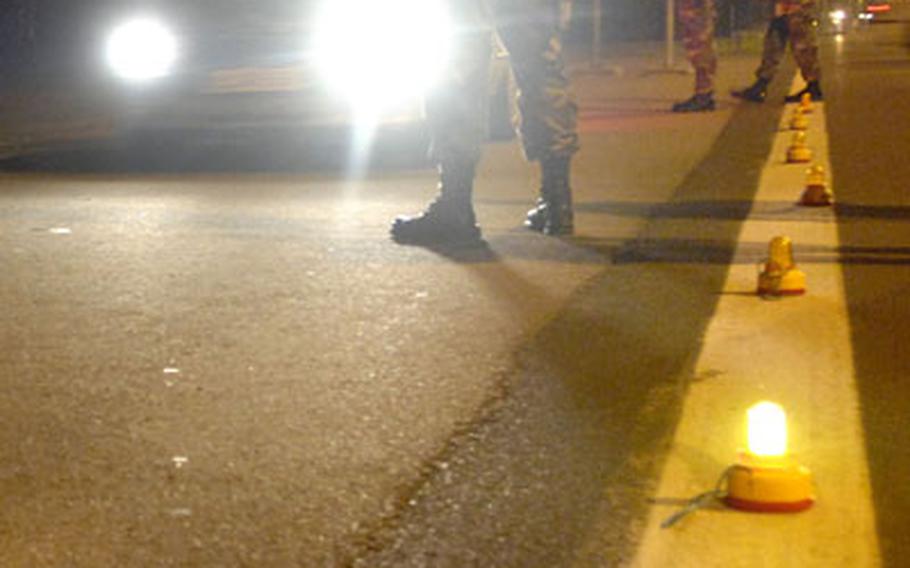
Werner Pfirrmann, a civilian local national from the 435th Security Forces Squadron, stops a vehicle at a DUI check-point just outside Ramstein Air Base’s west gate Aug. 26th. Statistically speaking, those living or working at U.S. Air Forces in Europe bases face a lot less crime than similar-sized populations in the States. (Ben Bloker / Stars and Stripes)
European edition, Sunday, September 9, 2007
The acronym for U.S. Air Forces in Europe is USAFE, not U-SAFE or URSAFE.
But, statistically speaking, the command could argue that the other terms are generally appropriate.
Not that it feels compelled to do so.
“The last thing you want to do is brag on your safety record,” Command Chief Master Sgt. Gary Coleman said, citing personal experience as proof. He recalls a conference in which he proudly stated the command had yet to have an airman commit suicide that year. The next day, the first one occurred.
Still, the command does believe that its bases are generally safe for its airmen and their families.
“If I didn’t feel that way, I wouldn’t have my wife with me here,” said Col. Lyle Cary, deputy director of security forces for USAFE.
Crimes, however, do occur on a daily basis on or around USAFE bases. They’re recorded in the Security Forces Management Information System, a computer-based program that allows officials to view basic information on individual cases as well as track trends.
Coleman said he and Gen. Tom Hobbins, the USAFE commander, do that every month.
What have they seen this year? Through Aug. 15, USAFE recorded 448 assaults, four rapes, 34 suicide attempts or gestures, 1,075 cases of larceny, four robberies, 179 citations for drinking and driving and two cases of manslaughter involving community members.
Cary points out that the numbers entered into the system don’t necessarily mean a crime has occurred or that a conviction is imminent. They just indicate that police are investigating specific charges.
Stars and Stripes requested a wide range of crime statistics from the command in May, asking for yearly figures dating back to 2004. The seven largest bases eventually responded with their own statistics before USAFE decided to compile all the figures and talk on the subject.
Officials say that USAFE crime statistics, compiled in a manner consistent with that used by the FBI, compare favorably with similar populations in the States. The number of assaults per 1,000 people, for instance, was 8.82 in USAFE in 2004. The U.S. figure during the same period was 28.86 — or more than three times as prevalent.
In some categories, the number of incidents at USAFE bases is so rare that if a few incidents do occur, the percentages can change dramatically. That’s the case with rapes. The total reported was 12 in 2004, but dropped to two each for 2005 and 2006. Four bases — Aviano, Incirlik, RAF Lakenheath and RAF Mildenhall — didn’t report a single rape during the four-year period.
Other types of incidents, such as drinking and driving, are much more common. Coleman said the command has made concerted efforts to address alcohol use. He noted the total through Aug. 15 (179) is about half of what it was in 2004 (364). That appears to be part of a trend, following lower citations in 2005 (276) and 2006 (271).
But keeping airmen’s attention on the subject — or any safety or security matter — is a challenge, he said. People tend to tune out a message they’ve heard over and over again. And about half the military population changes in Europe every 18 months anyway.
“You do have to re-educate the population on a constant basis,” Coleman said. “It’s important that you get the message out. You can’t just throw up your hands and say: ‘There’s always going to be DUIs … There’s always going to be larceny… ’
” Sometimes the perception of safety on bases is actually counterproductive, Cary said.
Addressing larceny across the command — likely to top 1,300 cases for the fourth straight year — he said “the overwhelming majority” occur because people simply fail to lock the doors of their cars or homes. Only “once in a great while” do investigators run across individuals who would be considered professional thieves on crime sprees.
“You can look at our installations kind of like gated communities,” he said. “We are very robust gated communities. But it takes an entire community to create a safe and secure environment.”
Crime stats are reflection of host areas
Incidents outside the gates of U.S. Air Forces in Europe bases aren’t tracked by USAFE officials with the same regularity as criminal behavior on base. That’s because most of those incidents are handled by local authorities, who have primary jurisdiction.
But the command says that the relatively low crime statistics on base are also a reflection of the local communities its bases are located in.
Areas where there is heavy illegal drug use, for instance, would likely carry over to the base population. And most of the command’s active-duty and civilian population live off base.
Lyle Cary, deputy commander of USAFE security forces, said efforts by local national law enforcement agencies generally don’t receive a lot of attention — until there are incidents such as the arrest last week of suspected terrorists allegedly targeting U.S. facilities in Germany.
“We recognize that there are bad people out there who want to do bad things to us, given the opportunity,” Cary said.
“I think you have to give a tremendous amount of credit to our hosts here. They keep us safe.”
— Kent Harris